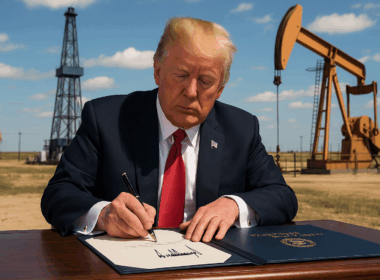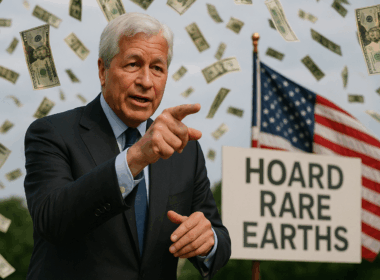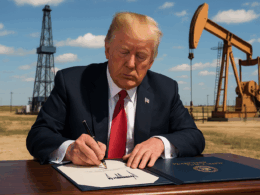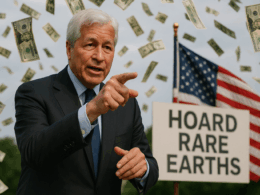Dear Readers,
For the first time in a decade, the stock market sang a different tune. Over the last ten years, the market was Walking on Sunshine.
In the last few months, that tune quickly turned to Doom and Gloom. The end of 2018 sent an alarming and disturbing signal to everyone in the market: be careful.

Not only did the market head into bear territory, but we also capped off the year with the worst December for stocks since the Great Depression.
And for the first time since 2008, the S&P 500 ended the year in the red. Even Google searches for “recession” spiked in December. Oh, and let’s not forget that stocks haven’t started a year this badly in nearly 20 years.
Luckily, we were prepared.
Today, I want to share my early predictions for 2019: what to expect, what to look out for, and most importantly, how to invest in these uncertain times.
A Blast from the Past
In our April 2018 edition, our analysis allowed us to see the pain ahead – but not before taking advantage of the short-term market gains.
Via “Is the Market on the Brink of Collapse?“:
“…The S&P 500 is down over 9% from its 2018 highs set in January (2018) – a number that has sparked market jitters for many investors, especially since stocks were up every month of the year in 2017.”
But instead of running, I went on to give reasons why the market had more room to grow.
“…However, before we speak of doom and gloom, it’s important to note that the S&P 500 is down only 2.58% year-to-date (TYD).
…Q1 earnings are expected to be strong – so strong that analysts have recorded record-high increases in S&P 500 earnings per share (EPS) estimates for both Q1 and 2018 to date.
…according to FactSet, the first quarter of 2018 marked the largest increase in the bottom-up EPS estimate over the first two months of a quarter since it began tracking the quarterly bottom-up EPS estimate in Q2 2002.
…the estimated earnings growth rate for the S&P 500 in Q1 is 17.2%. If those estimates prove correct, it will mark the highest earnings growth per quarter in seven years, when we hit 19.5% back in Q1 2011. The S&P 500 is up over 95% following the end of Q1 2011.
…of the 11,094 ratings on stocks in the S&P 500 FactSet tracks, 52.2% are Buy ratings, 42.9% are Hold ratings, and 4.9% are Sell ratings.
…these numbers show that, despite the uncertainties surrounding the market, fundamentally the market remains sound.
Do I think we have another 100% gain ahead of us? Of course not.
But I don’t think it’s time to make rash decisions just yet.
Be sure to keep an eye on earnings in the coming weeks – if they fall far below expectations, serious caution is warranted. If they meet or beat them, a sigh of relief is in order for the short term.”
And that sigh of relief followed that Letter, when earnings overall remained strong.
The S&P 500 then climbed from 2581.88 at the beginning of April to a high of 2940.91 in September.
But just as I suggested that the market had more room to climb following the disastrous start to 2018, I also suggested that we should be much more cautious heading into Q3 as a result of the competition for capital and the causality of inflation as a result of Trump’s policies.
“…capital is always in a state of perpetual competition. With the abundance of US bond supply expected to hit the market, better bond terms will likely be required in order to compete for capital – especially since yields are still near all-time lows.
That means yields will eventually have to go up. In Layman, interest rates will have to rise. And if interest rates rise, capital will shift from the equity markets over to the bond market.
…The consensus from bond experts are that yields will rise, but they will have to rise slowly because both the US and global economies are too highly leveraged to sustain a rapid rise in rates.
Especially when inflation is finally back on the map…
…In February, we witnessed the release of a very robust jobs report which showed that wages increased 2.9 percent year-over-year in January.
This was the biggest increase since 2009 and further enforces that the US economy is, in fact, gaining strength.
Unfortunately, while this growth is a good thing, it does put pressure on the stock market.
That’s because this economic strength provides a natural upward force on interest rates and bond yields, as it paves the way for the Fed to tighten and increase rates.
We witnessed this first hand in January when the Consumer Price Index, a key indicator of inflation trends, climbed well above expectations, jumping 0.5 percent. This immediately led to higher bond yields and lower stock prices. In a normal market, growth should lead to higher stock prices.
However, in today’s Fed-supported market, it has the opposite effect.
… As inflation rises, long-term bond yields will have to keep up in order to give investors a real rate of return (a return that factors inflation).
With inflation now steadily rising above 2%, combined with an increasing supply of US bonds, long-term bond yields should move closer to 5%; giving investors a real rate of return in the vicinity of 3%.
These expected rise in yields could be the beginning of a bigger shift from stocks to bonds and stagnate the growth of the stock market. We should be more cautious of this event in Q3 and Q4.
… That’s why over the next few months, I’ll be adding big positions to my portfolio in hopes of hitting that grand slam before Q3/Q4 is here.”
And I certainly did add some big positions, including a stock which I introduced at a price of C$3.65 that ran to over $10 per share before Q3 arrived – a potential gain of over 175% in just a few short months.
My purpose for revisiting the April 2018 edition isn’t to tout the accuracy of my prediction, or to show you how we were able to make big profits during a time of uncertainty; it’s to show you how we can take those same cues into 2019 and win.
What to Look for in 2019

The Convergence of Interest and Unemployment Rates
Despite the concerns of a trade war and other global issues, 2018’s late stock market declines were generally driven by inflation and interest rate concerns – which we highlighted as the key indicators for capital competition.
In 2019, these concerns will likely remain the key driver for stocks and bonds, and we should be watching them closely.
But outside of the shift from equity to bonds, there’s another indicator we should be aware of this year: the convergence of the inflation and unemployment rates.
When unemployment and inflation rates converge – when they become the same number – it’s often a sign of an overheating economy; one that historically marks the beginning of a prolonged downturn for stocks, followed by a recession a year later.
Right now, the gap between unemployment and inflation is around 1% in developed countries like Japan, the UK, Germany, and the all-important United States.
In other words, if the Fed maintains its “not so many rate hikes” in 2019, but unemployment continues to get better, we could be looking at a very slow 2019 for stocks, followed by a potential recession in 2020.
And while the U.S. economy is strong, a downward shift in stocks can immediately send the economy reeling back.
Consumer Confidence
When consumer confidence drops, stocks almost always do as well.
Last year, the consumer confidence September’s index print hit 138.4, nearing the all-time high of 144.7 reached in 2000, according to the Conference Board.
So it’s no surprise that stocks also hit their 2018 highs in September.
But shortly after, consumer confidence began to dip – and in lock-step, so did stocks.
In December, consumer confidence dipped again, leading to the worst December for stocks since the Great Depression – showing just how volatile our market can be.
In other words, we should keep a monthly tab on the consumer confidence reports as there is a reasonably high correlation between the stock market and consumer confidence.
Government Issues
In March, we’ll likely have the debt ceiling reinstatement.
What’s the debt ceiling?
From Wikipedia:
“In the United States, the federal government can pay for expenditures only if Congress has approved the expenditure in an appropriation bill. If the proposed expenditure exceeds the revenues that have been collected, there is a deficit or shortfall, which can only be financed by the government, through the Department of the Treasury, borrowing the shortfall amount by the issue of debt instruments. Under federal law, the amount that the government can borrow is limited by the debt ceiling, which can only be increased with a separate vote by Congress.”
In other words, the debt ceiling is often used as a bargaining tool for political advances when the House and Senate are controlled by two different parties, since an increase in the debt ceiling requires approval of both the House and the Senate. The last time we had a gridlock between the two parties over the debt ceiling was in 2011.
After many months, the parties finally agreed to raise the debt ceiling. But this Brinksmanship led to a U.S. debt downgrade for the first time in history, sending the market down nearly 20% – a baby bear market, if you will.
If the government can’t sort out their issues, we could be in store for some significant volatility in Q2 that could also lead to a baby bear market.
Around the same time, we have the ceasefire deadline in the trade war between China and the U.S. Both countries would fair better if the two can come to an official agreement, but taming two alpha males on a world stage is not an easy task. And don’t think for one second that China won’t use the debt ceiling deadline to its advantage.
The timing of both the trade war and debt ceiling deadlines will further add to the instability of the market in Q2. That means cash is king and will once again be considered a strong asset class in 2019. But that doesn’t mean we should run..
An Optimistic Outlook
Despite a weak December performance and a drop in consumer confidence, the shopping season was a rather robust one, with Mastercard saying it had its best season in six years.
Meanwhile, US job creation ended 2018 very strong, with nonfarm payrolls surging by 312,000 in December.
Via CNBC:
“Job creation ended 2018 on a powerful note, with nonfarm payrolls surging by 312,000 in December though the unemployment rate rose to 3.9 percent.
The jobless rate, which was last higher in June, rose for the right reason as 419,000 new workers entered the workforce and the labor force participation rate increased to 63.1 percent. The participation level was up 0.2 percentage points from November and 0.4 percentage points compared with a year earlier.”
In other words, with the Fed looking to calm interest rate hikes in 2019 and unemployment rate slightly rising (for the better), the convergence of interest rates and unemployment moves further apart – potentially signaling a little more room for stocks to climb.
With the recent market correction, the S&P forward 12-month price-to-earnings ratio in December dropped to 14.2, according to FactSet – lower than both the 5-year average (16.4) and 10-year average (14.6).
Lastly, a positive outcome on the trade war could help bolster the market – as could a positive outcome on the debt ceiling.
I suspect the market to be optimistic in the short-term, but how long this rebound lasts remains to be seen.
Keep this in mind for Q1.
A Big Year for Europe

While the market is focused on the trade war between the U.S. and China, we certainly shouldn’t forget about Europe.
That’s because we are going to witness a record year for political changes in one of the world’s largest economies.
In March, the UK is expected to leave the European Union (EU) officially.
Shortly after, the EU will be electing a new Parliament, followed in the summer with the appointment of a new President.
Then in the fall, the 8-year run of Mario Draghi as President of the European Central Bank (ECB) will be over, and a new president will be selected.
All of these political events could have wide spreading implications for global markets. For example, what if the new head of the ECB is strongly opposed to loose monetary policy?
Outside of interest rates, the debt ceiling, and the trade war, we should be keeping a very close eye on Europe.
Conclusion
I would never suggest being completely in or out, of any market. By taking the cues from 2018 into 2019, I believe there is still ample room to profit.
However, it must be timed correctly.
For example, I continued to add big positions following the small dip in Q1 of 2018 but pulled out a large chunk before Q3 based on market events that I outlined in my April 2018 edition. In hindsight, I probably should have pulled out more – but profits are profits.
In 2019, I could see a very volatile Q2.
That means one could invest now, pull out before Q2, and then buy back once the debt ceiling and trade war issues are sorted out.
Outside of the complexities in March and Q2, history is somewhat in our favour when it comes to stock market performance.
Stocks are not only cheaper now than they have been in the last 10 years from a P/E ratio perspective, but the S&P 500 has only declined in back-to-back years four times since 1929.
And while the Fed and other central banks are on a tightening path, China is more than willing to do the opposite.
For example, it just lowered the level of cash that banks must hold as reserves to boost liquidity and support private companies caught between the U.S. trade war and Beijing’s deleveraging effort.
Via the Nikkei:
“The 1-percentage-point cut to reserve requirement ratios marks the first such move since October, and focuses attention on whether the People’s Bank of China will next lower policy interest rates — something it has not done since fall 2015.
The reserve ratio cut, which is expected to free up a net 800 billion yuan (US$116 billion) for banks to channel into financing, shows Chinese authorities taking a more accommodative monetary policy stance than in 2018 as trade tensions add to the pressure on the economy.
The PBOC said in a statement accompanying Friday’s decision that it will “continuously implement prudent monetary policy,” dropping the word “neutral” used when it cut reserve requirements in October. The omission, which indicates a looser stance, follows a decision by the Central Economic Work Conference — an annual meeting of top policymakers — to delete the term in December.”
In other words, what may appear shaky at first could turn into prime trading opportunities if we’re cashed up.
Last year, we were able to profit despite all of the uncertainties in the market.
We just had a fairly big win on our most recent idea first introduced in September, and I suspect we may have another leg up from here with the recent downturn.
I am looking to introduce another opportunity to profit in these times of uncertainty – very similar to the structure of the great trade we experienced last year that led to a potential 175% win in just a few short months.
Be sure to keep an eye on your inbox as timing is everything in this market.
Seek the truth,
Ivan Lo
The Equedia Letter
www.equedia.com
Disclosure:
Equedia.com and Equedia Network Corporation are not registered as investment advisers, broker-dealers or other securities professionals with any financial or securities regulatory authority. Remember, past performance is not indicative of future performance. This article also contains forward-looking statements that are subject to risks and uncertainties that could cause actual results to differ materially from the forward-looking statements made in this article. Just because many of the companies in our previous Equedia Reports have done well, doesn’t mean they all will.













you seem to forget EMC And VIVO {ABACANN}
Hi Don,
When we first introduced Emblem, it was just below C$3 and ran to over $4 within the next few weeks. However, we did feel that depsite the small run, Emblem was not one of our better ideas. As for Abcann/Vivo, we first introduced it between $1-1.50 on its opening day of trade. While the stock is currently down along with the recent marijuana downturn, it did run to nearly $4 just over 6 months after our initial report, potentially giving some readers a near 300% profit if timed correctly.
We hope this helps.
Thanks for your comment.
I have never invested in anything in my life. Thus seems like a good invest if I can come up with the money.
I followed your BUY recommendation on WTER and now am underwater ? What happened ?
Hi Jim, we first introduced WTER below US$2 per share in September. The Company is currently trading at US$2.88, but ran as high as US$5.50 in the subsequent months. With the recent pullback in the overall stock market, we believe it also affected WTER. Furthermore, the release of an early private placement has put pressure on the stock. We feel that once this pressure subsides, and if the market can stabilize, WTER could go higher from here. However, please note that this is our analysis and you should conduct your own research before making any decisions. Thanks and we hope this helps.
I enjoyed reading this informative review. Will the DOW go up or down when the “*******” moron leaves office?
Rex Tillersons words, not mine.
down,down,down
I am new at this and would love to learn more.
thankyou i enjoy reading thisi newsletter in updo dating myself
Economy
LOL… I just love all these “expert analysis”, but at the end of the day, Mr Einstein summed it all up perfectly with “Insanity: doing the same thing over and over again and expecting different results!”
Oh, and btw, seen “The Big Short”?
After all that film revealed about the criminally insane CDO ponzi scams, the last caption read….
“In 2015, several large banks started selling billions in something called a “bespoke tranche opportunity.”
Which, according to Bloomberg News, is just another name for a CDO.” – and those slimy presstitutes should know…
“You have no idea of the crap people are pulling (STILL) and everyone is walking around like they’re in a goddamn Enya video”!
https://www.youtube.com/watch?v=jmCN4F9SgNY
Just like all the others who profess their knowledge
Of the markets U are just giving Ur Personel
Thoughts —-so did al the hedge funds that went under—I have yet to see anyone of U with any kind
Of guarantee
Last year I showed a very small profit which was better then most my strategy is the only one that
People should use— good in almost any situation
If u want to know what it is just e mail me — it is simple and will not involve much of ur time
It just wirks
Please send info I’m retired an looking to start something small
I just loved that word ” presstitutes”.
I’m still smarting from reading a Seeking Alpha article in which the author seemed pretty emphatic that TTD was just not worth $49. As soon as I sold something like 20 -40 shares, it doubled, if not the very day after I read the article, in less than a week. I waited for it to come down to buy more. It doubled again!!! Basically, I think I’m learning to never argue with the wisdom of David Gardner (knock on wood). Either that Seeking Alpha guy was a presstitute, I think (or maybe trying to acquire some great stock at a cheaper price?), or David Gardner had enough $ to make a point clear: his genius does not pick losers. Since another stock picker recently joined The Trade Desk bandwagon, I reaquired 1 lonely share.
While some of your advice has proven questionable, I do believe you are right here and that investors really do need to be cautious in 2019 as we are just playing with fire right now.
Looking forward to reading more of your recommendations & letters.